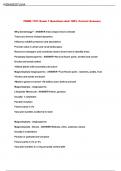AGRADESTUVIA
FNRM 1101 Exam 1 Questions And 100% Correct Answers
Why Dendrology? - ANSWER trees impact micro-climate
Trees are drivers of plant dynamics
Influence wildlife presence and abundance
Provide value in urban and rural landscapes
Resource managers and scientists need to know how to identify trees
Pinophyta-Gymnosperms - ANSWER •No true flower parts -strobili and cones•
Ovules and seeds naked
•Oldest plants with secondary structure
Magnoliophyta-Angiosperms - ANSWER •True flower parts - stamens, pistils, fruit
•Ovules and seeds enclosed
•Modern genera evolved ~50 million years before present
Magnoliophyta - Angiosperms
Liliopsida- Monocots - ANSWER Palms, grasses
Usually: 1 cotyledon
Parallel venation
Flower parts in 3's
Vascular bundles scattered in stem
Magnoliophyta - Angiosperms
Magnoliopsida - Dicots - ANSWER Walnuts, elms, cashews, beans
Usually:2 cotyledons
Pinnate or palmate leaf venation
Flower parts in 4's or 5's
Vascular bundles in a ring arounda central pith
,AGRADESTUVIA
Tree - ANSWER A tree is commonly defined as a plant with one single, woody, perennial
stem reaching a mature height of more than 20 feet. OR (or 13 feet, or 15 feet, etc)
shrub - ANSWER Shrubs are commonly defined as multi-stemmed, woody, perennial
plants which seldom reach over 20 feet in height.
Vines - ANSWER The term vine lianas is usually reserved for perennial, climbing, woody
plants. This class of plants usually requires support for upright growth.
names - ANSWER Names- scientific and common names; family
form - ANSWER Form- tree or shrub
range - ANSWER Range- roughly where is it located?
Morphological traits - ANSWER Morphological traits - how to identify it
Silvical traits - ANSWER Silvical traits - reproduction frequency and method, site
requirements, growth rate, wood strength etc
Uses - ANSWER Uses- ecological, economical, cultural
Common associates - ANSWER Common associates - other species growing with it
Insects and diseases - ANSWER major impacts
Family Magnoliaceae - ANSWER •Most ancient of Angiosperms
•7 genera and 220 species worldwide
, AGRADESTUVIA
•2 genera and 9 species native to N. America
•Botanical features of the family
Leaves: deciduous or persistent, alternate, simple, stipulate Flowers: large, showy,
solitary, perfect (rarely unisexual) Fruit: conelikeaggregate of follicles or samaras
Magnolia acuminata - cucumbertree - ANSWER -Leaves: deciduous, alternate, simple,
ovate (4-10" long; 3-6" wide), entire, acute to acuminate. Flowers and fruit: flowers
greenish yellow (1.5 -3.5" wide), fruit a follicle resembling a cucumber (1.5-3" long)
producing 10-60 seeds in red leathery casings.
Twigs: moderately stout, reddish brown, terminal buds large, silver and silky.
Bark: brownish grey with narrow flaky ridges.
Range: Lake Ontario to central LA, eastern OK to central VA.
Size: Large, relatively shortlived tree to 150 yrs, reaching 100 feet and 3648
inchdbh(max), pyramidal crown with straight, clear, slightly buttressed bole.
Reproduction: perfect flowers, insect pollinated. --Site: moist, fertile soils on
bottomlands and north and east slopes, associates include other hardwoods i.e., white
and red oaks, hickories, black tupelo, beech, ashes, tuliptree.
-Shade tolerance: mid-tolerant of shade
-Economic importance: a soft hardwood, used like tulip-poplar, interior parts on
furniture, interior trim, doors, boxes, pallets, horticultural uses due to flowers.
-Ecological importance: seeds readily eaten by birds and small mammals.
Magnolia grandiflora - southern magnolia - ANSWER -Leaves: persistent (2 yrs),
alternate, leathery, ovate, entire, acute, bright green and lustrous above, green and
rusty tomentose below.
-Flowers and fruit: large, white, fragrant, perfect flowers, resulting in tan tomentose
follicle.
-Bark: dark grey, starts smooth, becoming furrowed and scaly
-Twigs: rusty tomentose, terminal buds same
-Range: Atlantic coastal plain from NC tocentral FL and Gulf coast to eastern TX.
Size: medium sized, commonly 60-100' tall and 2-3' dbh.
Reproduction: Prolific seed producer. Also reproduces from stump sprouts, root
sprouts and layering.




